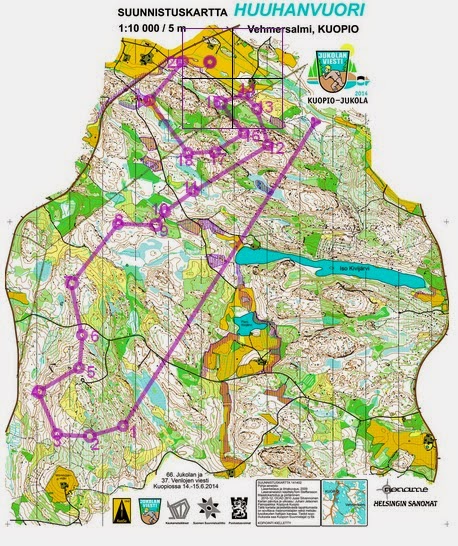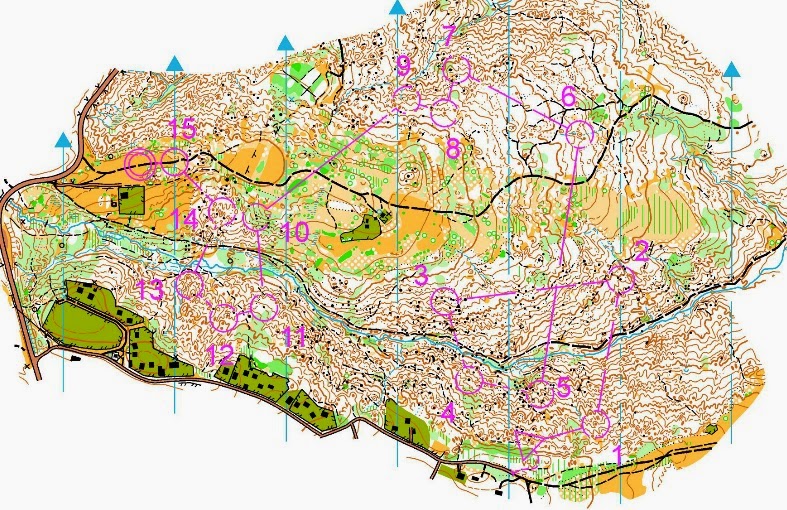We start this issue with Helen Baxter's report on the Veteran Home International in September in the Forest of Dean (in England although most of us thought we were in Wales ...). The Juniors beat Wales, would the Veteran's follow suit?
(or Veteran Home International 2014 Report)
This year’s Veteran
Home International was held in conjunction with the Caddihoe Chase in
the Forest of Dean; a type of terrain that Irish runners rarely get
to experience - mature mixed woodland with old mine workings,
charcoal burning platforms and plenty of deer and wild boar. The
maps had a high proportion of white which resulted in some fast times
– (although one or two vets complained that brashings didn’t
count as runnable!). The Youth Hostel had hot water which was a
definite improvement on last year although the bumpy, narrow, steep
access road was more than a little hair-raising for the drivers. For
the third year in a row the weather was great, no rain and some
sunshine as each day wore on. Ireland put in a full team of 24 and
everyone completed their races which meant points were scored by all.
There were some notable results on Day 1 with Marcus Pinker picking
up 4th in M40 and Angus Tyner coming 3rd in M45
plus Toni O’Donovan and Jean O’Neill coming 2nd in
their respective classes and Ruth Lynam winning W60 by 12 minutes!!
The dinner that evening was a welcome social occasion with the more
energetic members of the team opting to walk to and from the village
hall (a mere 5k round trip).
Ruth continued her
fantastic form on Day 2 by being the leading runner in on the first
leg of the Relays causing great excitement in the Irish team and a
certain amount of surprise elsewhere. This team came in 2nd
in the WMW class. Ruth you were definitely ‘Queen of the Forest’
this weekend (man of the match doesn’t sound quite right). Despite
some other strong performances in the relays (Marcus managed to pull
his team up 7 places in the MWM class) we didn’t quite manage to
catch the Welsh but there is always next year even if it is on their
‘home’ terrain at Teifi Pools (used in Croeso 2012).
The VHI weekend is a
great opportunity to run in different terrain, it tends to be a
relaxed and fun weekend. If you haven’t put your name forward
before – don’t be shy, while ability might be the main selection
criteria, availability is just as important. If you are over 35
Helen Baxter wants to hear from you – it’s never too early to
express an interest! Next year the event will be held over the first
weekend in October in Wales – get it in the diary.
Helen Baxter (VHI Team
Manager)
The annual Junior Home International competition
between England, Ireland, Scotland, and Wales took place at Oban in Scotland on August 30-31, just about the time the schools went back after the summer. .
The competition is for juniors of M/W 14 up to M/W 18.
After a tough weekend of racing, Scotland just pipped England for the
overall title, the battle only being decided by some of the very last
relay runners. Ireland won back the Judith Wingham trophy from Wales,
after a successful weekend, with some positive results.
For more detailed results, from each day, and the overall points, you
can go to the EckO website here.
For
pictures from the weekend (and there are a lot!), you can look to this
flicker
page here. The overall results were Scotland 129, England 127, Ireland 56, Wales 46.
Junior European Cup
 |
| Paul Pruzina (LVO) at JEC |
The team took the red eye flight to Eindhoven on Friday morning and after settling in at the accommodation in a complex consisting of hundred of small houses, were ready to start around 5 pm for a sprint race though the mostly pedestrianised city of Lommel. Full quarantine procedures were implemented with a slight panic when we were told that one of the controls had to be moved from an underpass to the top of the bridge due to an unhappy resident. Paul Pruzina had an excellent run in M18 to finish 36th in a time of 15 min and 3 sec just 1.46 behind the winner Joey Hadorn from Switzerland. Roisin finished in 39th just 2.42 behind the winner. Eoin in M20 finished just 1.58 behind the winner Oskar Andren from Sweden while Niamh finished in 44th on W20.
The long distance was exactly that: 13.8 km for M20 to 9.1 km for W18. Nevertheless, the terrain was pretty flat meaning that the running was fast and winning times around the hour. The day was hot (23 degrees) and sunny to match the beach atmosphere in the sandy finish area. The start was from a military compound several km from the finish. Roisin finished in 41st position 19 minutes behind Tilda Johansson from Sweden who completed the course in 60 min. Paul was 42nd while Eoin was 46th in M20 where the winner, Anton Johansson, won by a phenomenal 6 minutes with local favourite Tristan Bloemen in 6th only 50 seconds off second place.
The relay on Sunday morning was in similar sandy and forested terrain, the hint being the name of the map: the Sahara. A compact field acted as start, spectator control and changeover. There were only two relay classes, M and W, and with over 30 teams in each, there was a great atmosphere at the start and throughout the race. The spectator control was particularly entertaining with several runners literally passing the control and failing to notice it resulting in loud callbacks. While Anton Johansson put in another stunning run to come home clear by more that a minute in the first leg, the Danish men came through just like their women’s team to win. Ireland M team was lead off by Eoin who had a great run, as did Paul and Róisín who came close to embarrassing GB and German teams.
The Belgian organisation was top class and just as impressive was the support of their athletes no matter what position they were in. This is an excellent team competition held in reasonably convenient places for us in Ireland and over a short time span. However it is during school term. Next years competition is in the northern part of Germany. Will we be there?
See the JEC website here and JEC reports, interviews and maps here.
Regional Championships
The Northern Ireland Championships were run by Fermanagh Orienteers on a new map just across the border in Co. Cavan, at a scout centre called Castle Saunderson, on 4th October. Cork O's Darren Burke travelled from Munster and had a convincing 4-minute win over Hugh Cashell (CNOC) in M21Long, with Steven Linton (NWOC) the NI Champion in 5th place. On the W21 Long course, Ruth Lynam (CNOC) showed a clean pair of heels to the rest of the field, a thing she has been doing since she was a slip of a girl, finishing 8 minutes clear of NI Champion Olivia Baxter (LVO). You can see the full results, routes and split times here. You can see the full list of Norhern Irelend Champions here.
The 2014 Munster Championships are at Muckross, Killarney, on November 2nd but entries have closed, at least in theory - maybe if you contact Kerry Orienteers they'll still let you come and run in the Kingdom. See the event details on the Kerry Orienteers facebook page here. Muckross is a really good area, with a mixture of runnable mountainous forest and parkland dotted with islands of intricate forest. It was used for the Relays at the 1998 World Cup races in Ireland and for Shamrock O-Ringens and Irish Student Championships and other high profile events.
The Connacht Championships are on a new Padraig Higgins map at Strandhill, Co. Sligo, which seems to be right beside Sligo Airport, so it might be possible to fly to the event, on November 16th. Galway-based Western Eagles are staging the event and cheapest entries are before 31st October with late entries to 7th November. See details here.
Waterford Orienteers stage an ambitious programme of three events under the "Déise Days" banner on the October Bank Holiday weekend, starting with a night-O on the dunes at Tramore on Saturday, a Munster/Leinster League event at Castlecomer, Co. Kilkenny on Sunday and a city race in the centre of Waterford on Monday. See details here.
September Saturdays
The adventurous orienteers in Setanta, CNOC, Ajax and 3ROC staged a great series of four mountain bike orienteering competitions on Saturdays in September, at Djouce, Curragh, Saggart and Three Rock, but unfortunately failed to ignite much enthusiasm except among the handful of entrants who took part. The events were great fun, challenging both physically and in the route-choice sense, though the actual navigation was straightforward. Maybe we're making MTB orienteering too difficult for the cyclists and too intimidating for the orienteers? The forests we use for orienteering are pretty steep and physical, but there must be other areas where it's possible for moderately fit people to ride all the way without having to dismount and carry or push: "root choice" was a particular feature of the Ajax event at Saggart, with lots of slippy tree roots on some of the tracke (but it looks like a popular MTB area). Would Mullaghmeen, Portumna, Donadea or Muckross be usable for MTBO, or those forests in the Ballyhouras? The problem is to get enough people to enter to make the events financially viable, and that still seems a long way off with only abgout 20 entrants. This is a pity as the two sports can combine really well, like banana and peanut butter ...
O-Bits
The seventh London City race was on September 21st in the financial heart of the City, and attracted an entry of more than 900 runners, from all over Europe, though very few from ireland this year. (There was a city race in Brussels the same day and at least one orienteer managed to run both races, travelling by Eurostar between the two capitals).The event finished in the multi-level Barbican Estate with its profusion of confusion: different levels, uncrossable boundaries and sloping surfaces. I was convinced at one stage that the planner was being too clever and tried to outwit him by running underground into a car park which, it turned out, hadn't been mapped. If I had run for a few more metres on the level I'd have seen my control as plain as day.
I was surprised to see a girl I didn't recognise running in an Ireland Team O-top but the top may have brought her luck as she finished 1st in the international "Euro Youths Women" class: maybe Barboro Pijakova is one of the Pijakovs of Ballyjamesduff?
Next year's race is on Sunday 12th September. See here and here for information.
North American Championships
Globetrotting W65 Jean O'Neill (Fingal Orienteers) reports from Canada, where she was one of a handful of Irish orienteers at the North American Championships in Ontario:
I took part in the
North American Orienteering Championships, near Ottawa in Ontario
last weekend. There were about 600 entries. Terrain for the Middle
and Long was very technical natural deciduous forest.. There was also
a sprint and relay in a park and streets beside a large lake. There
were a lot of very fit elites there-it was a World Ranking Event.
Most competitors stayed at the event centre and took all (excellent)
meals there. Shuttle buses brought competitors to the venues. It was
a sports centre so swimming was free!
I carried the flag for Ireland at the Opening ceremonies in the adjacent ice hockey arena.(we even got to see a game afterwards). Other Irish there were Ronan and Julie Cleary, and the Young family - Fingal's Ciaran's brother Alan and Mairéad and children.
There are only ten year age classes in Canada - 35 to 44 etc. - and from 75 up there are 5 year classes - there were quite a few of those! I had a great run in the Middle event on Day 1, and came first, beating the famous Sharon Crawford. I wasn't eligible to be North American Champion, but the first 3 in each class got awards in addition to the first 3 from NA. Prizes were presented after the dinner each day. Unfortunately my performances were not up to scratch in the Long and Sprint on Days 2 and 3. (Maybe all my scratches and rash from the undergrowth slowed me down?)
I carried the flag for Ireland at the Opening ceremonies in the adjacent ice hockey arena.(we even got to see a game afterwards). Other Irish there were Ronan and Julie Cleary, and the Young family - Fingal's Ciaran's brother Alan and Mairéad and children.
There are only ten year age classes in Canada - 35 to 44 etc. - and from 75 up there are 5 year classes - there were quite a few of those! I had a great run in the Middle event on Day 1, and came first, beating the famous Sharon Crawford. I wasn't eligible to be North American Champion, but the first 3 in each class got awards in addition to the first 3 from NA. Prizes were presented after the dinner each day. Unfortunately my performances were not up to scratch in the Long and Sprint on Days 2 and 3. (Maybe all my scratches and rash from the undergrowth slowed me down?)
Computers in O
Orienteering used to be just about maps and forests; now it's very much about computers too. We use them for mapping, for course planning, for communicating, for processing entries and results, so it's no surprise that IOA are running another "Computers in Orienteering" workshop, this time at the maldron Hotel near Portlaoise on Saturday November 22nd. See the IOA web site www.orienteering.ie for details. Places are limited but there may be one or two left. The cost is €25 per person. You can see how computing has developed since the 1987 World Military Championships in Ireland where computers were used to process results here.
Senior Home International
In a nail-biting finish, Ireland managed to pull one point clear of Wales to finish third in the 2014 SHI in the Aberdeen area on October 18/19th. Not to diminish the performances of the team as a whole, it is clear that the deciding factor in the weekend was the presence of Swedish-based Nick Simonin on the Irish team, running in Scotland in preparation for next year's World Championships. Nick finished first of the SHI runners in the M21 Elite individual at Balmoral, and had another blistering run in the Relay on the heathery dunes of Forvie. The overnight position was Scotland 48, England 46, Ireland 10, Wales 10. In the Relays England finished first with 26 points, Scotland 25, Ireland 11, Wales 10, making the final score Scotland 53, England 50, Ireland 21, Wales 20 - as usual a game of two halves.
This year featured a SHI-and-friends mixed sprint relay at Edinburgh ad Stirling a week before the SHI proper, along the lines of the one in last Summer's World Championships in Italy.Denmark won overall and Ireland finished 1 minute ahead of Wales, a premonition of what would happen at the main SHI.
See all the results etc at the Race the Castles web site here and here's a Scottish report on the event.
Congratulations .. to 2012 Irish Ladies Champion Maeve O'Grady and Dan Morrogh (DFO) on their wedding this week.
Quote of the day: “The secret”, said Niki Lauda, “is to win going as slowly as possible”. This applies to orienteering as much as to Formula 1 racing.
 |
| Niki Lauda |
That's all for now - watch this space for some photos and other snippets which might sneak in over the next few days ...
By the way, you can now follow The Irish Orienteer on Twitter: there's not much there yet but see here anyway! Thanks to Helen Baxter, Jean O'Neill, Brian Corbett and all the other people who, wittingly or unwittingly, contributed to this issue.
Remember, you can visit The Irish Orienteer's archives and read the orienteering news for the past 30 years or more here.







































